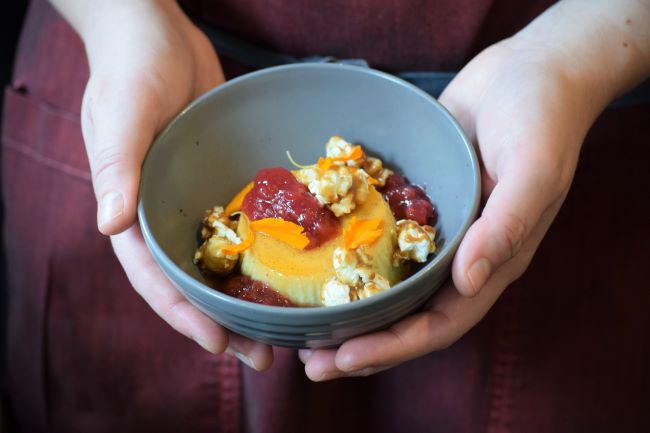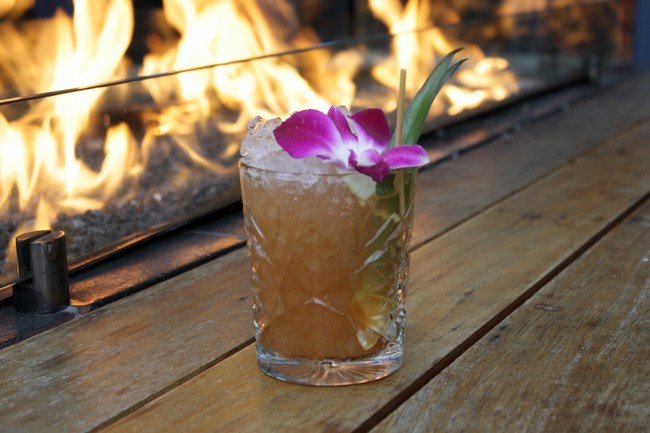You can expect to see licorice syrup, spicy tomato granita and orange wines across banquets, events, restaurants and bars in 2020, according to Kimpton Hotels & Restaurants’ sixth annual Culinary & Cocktails Trend Forecast.
Results of a survey of more than 130 chefs, sommeliers, general managers and bartenders from over 75 Kimpton restaurants and bars predict that the next year will bring more adventurous health ingredients and plant-based menus as well as lower-alcohol spritzes across both events and at restaurants.
From ingredients like seaweed, ashwagandha and nutritional yeast to dishes like ceviche featuring unexpected ingredients and flavorful Levantine cuisine, chefs are getting seriously creative while catering to consumers’ changing dietary and lifestyle preferences.
"Diners continue to be more educated, mindful and globally connected than ever before. We polled our experts around the world to get their insights on how consumer dining habits and dietary preferences will shape restaurants and bars in the year ahead,” said Scott Gingerich, senior vice president of Restaurants & Bars for Kimpton. “This forecast has been able to pinpoint cult classics a la last year’s Aperol Frose and predict the next big thing in flavors and ingredients like black garlic, s’chug and nutritional yeast for 2020.”
Here are all the food and beverage trends on Kimpton's annual list:
9 Culinary Trends
1. Alternative Diets Become Mainstream
- Diets once considered alternative are now the norm, so expect to see gluten-free, dairy-free, vegetarian, vegan and keto options become menu mainstays. According to 31% of the chefs surveyed, it’s no longer enough to have just one or two of these options on the menu.
- We’ll see more gluten-free options in traditionally carb-centric dishes like pasta and breads, using almond flour, rice flour, guargum or tapioca.
- Oat and hemp milks will continue to dominate menus in 2020, alongside nut-based, dairy-free cheeses, creamy cashew cheese alfredo sauces, plant-based burgers topped with vegan cheese, oat milk honey lavender lattes.
2. Not-So-Obscure Health Ingredients
- Health ingredients are moving into the spotlight—alternative milks, plant-based ingredients and superfoods are now commonplace compared to still up-and-coming items like nutritional yeast, ashwagandha plant, collagen peptides and seaweed.
- As an evolution of last year’s trend, fermented foods with gut-healthy probiotics are continuing to grow in popularity with tempeh, pickled vegetables, infused vinegars and fermented dairy products.
3. Plant-Based Everything and Sneaking in Vegetables
- 51% of respondents predict plant-based meat alternatives will solidify their mainstream status in 2020 and we’ll see more plant-based takes on traditional meat dishes.

Photo: Il Solito, Hotel Vintage Portland. Credit: Kimpton Hotels & Restaurants
- Hiding healthy ingredients are not just for kids anymore—chefs will also be “sneaking” more vegetables into pasta, pizza, breads and sauces, and even creating full-vegetable burgers, jerky and chips made from ingredients like mushrooms, eggplant, sweet potatoes, carrots, spinach or cauliflower.
4. Love for Levantine Cuisine
- Levantine cuisine, including Israeli, Turkish and Lebanese, is predicted as the most influential style for menus in 2020, according to nearly 40% of chefs surveyed.
- S’chug, a Mediterranean hot sauce, and muhammara, a red pepper and walnut spread found in Turkish and Levantine dishes, topped the list for spreads and sauces in this year’s forecast.
5. Cross-Cultural Fusions
- Local, responsibly sourced ingredients that bridge traditional culinary lines and blur the fusion moniker will continue to grow in 2020.
- Dishes that bridge culinary regions will be among the most popular trends, with more than half of chefs incorporating cross-cultural fusion dishes onto menus. These can include Mexican and Southeast Asian cuisine, French with Scandinavian flavors and Cantonese Chinese and Peruvian.
- Expect to see regional and indigenous-inspired cuisine, including more Native American, Scandinavian, Peruvian and Russian influences.
6. Funky Flavors and Sweet on Sour
- Ingredients with sour flavor profiles like rhubarb, tamarinds and vinegar will grow in popularity, with nearly 23% of chefs selecting sour as their favorite experimental flavor.
- Chefs also noted that funky flavors will make their way into breakfast staples, including licorice and salty syrups and savory oatmeal made with bone broth.
- Diners can also expect to spot more exotic peppers like Gochujang, piri piri, espelette and Hatch chile peppers in their dishes, with one in five chefs selecting peppers as their top ingredient for 2020.
7. A New Wave of Spices and Ingredients
- Ceviche featuring unexpected ingredients—from spicy tomato granita to pickled carrot to whipped avocado—was the top dish prediction for nearly one-third of respondents.
- Unusual seeds like lotus, basil and water lily seeds are predicted as one of the trendiest ingredients, according to 31% of chefs surveyed.
- Makrut lime leaves, pandan and black garlic, which offers a sweet, earthy flavor and a date-like consistency, emerged as top ingredients on this year’s forecast.
- Schmaltz, or rendered chicken or goose fat, will also be trending in 2020, according to a quarter of Kimpton’s chef respondents. Keep an eye out for schmaltz croutons accompanying roasted chicken dishes, and schmaltz as the new olive oil for dipping baked bread.
8. Restaurants With a Purpose
- According to the report, local collaborations will be king in 2020. Partnerships with local artists, distillers, farmers, purveyors, community members and more will be important to diners and restaurants alike.
- The social trends predicted as the most impactful on restaurant philosophies in 2020 include transparency across ingredients, sourcing and production, and policies to reduce restaurants’ environmental footprints.
- Sustainability will also continue to take center stage. Restaurant and bar managers, chefs and bartenders will continue to incorporate composting, zero-waste techniques and eliminating single use plastic items.
9. Dessert Trends
- “Grown-up sundaes” using locally sourced, often unexpected ingredients will be one of the top dessert trends, according to one in five chefs.
- A majority (47%) of respondents highlighted vegan desserts as the strongest sweet-tooth trend for 2020.
- Expect to see more unique savory-meets-sweet pairings like black pepper or sesame ice cream and truffle macarons.
7 Cocktail Trends
1. Inspired Ingredients
- Grilled, roasted and fire-blasted fruits, as well as tea-infused spirits and syrups, rose to the top of the trending ingredients, with bitter vermouths and wine as cocktail ingredients as runner ups.
- Aromatic (inedible) garnishes were cited as one of the up-and-coming trends bartenders are most excited to experiment with in 2020. Examples include spice sachets with cloves and allspice, burning sticks of wood or even absorbent, scented squares of paper clipped to glassware.
2. Culinary-Crafted Cocktails
- Kimpton bartenders predict that bars will continue to leverage culinary techniques in cocktail prep. The industry will see more bartenders learning from chefs (and vice versa) as bar and kitchen collaboration only increases.
3. Spritzes Reign Supreme
- Influences from Mediterranean regions will shape bar menus, according to the majority (46%) of respondents. We’ll see light, refreshing, often low-alcohol spritzes all over bar menus in 2020. These lower-sugar, crisper cocktails are the next evolution of the Spanish gin and tonic, which took over bars a few years ago.
- Spritz culture will also affect coffee programs, according to nearly a third of respondents. Drinks like the espresso tonic will be requested all year round.
4. Liquor Trends
- Expect to see the rise of alternative-grain spirits like baiju, shochu and soju, spirits that originated in China, Japan and Korea, respectively.
- Mezcal will continue to dominate in 2020, with more than a third of respondents choosing it as the predicted spirit of choice next year. Bartenders are having fun with its smoky spirit and using it to reimagine traditional cocktails in an unexpected way.
5. Whisky Highballs
- Whisky highballs—a trend largely driven by the popularity of lighter Japanese whiskies—are predicted to gain a cult following next year, followed closely by spiked seltzers and the return of the Paloma.
6. Beer and Wine Trends
- More than a quarter of bartenders are most excited about sour beers in the year ahead, followed by hazy or juicy IPAs and high-alcohol kombuchas as a beer alternative.
- Next year’s biggest wine trend will be the emergence of more natural wines, or wines farmed organically without adding or removing anything in the cellar. Orange wines and pet-nat sparkling wines are also becoming more popular with wine aficionados.
- Just as spirit enthusiasts are adding hard seltzers to their coolers, wine connoisseurs are seeking out unadulterated wines that are naturally low in alcohol, like Vinho Verde or txakoli.
7. Non-alcoholic Beverage Trends
- Many experts are predicting coffee spritzes as the drink of 2020. The other top coffee trends for 2020 include nitro coffee on tap, cold brew alternatives and CBD coffee.
- Botanical infused sparkling drinks are cited as the non-alcoholic trend bartenders will most likely experiment with, followed up by alcohol-free spirits and up-leveled teas with exotic fruit flavors like guanabana, lulo and passionfruit.
- The majority (42%) of bartenders surveyed are excited to embrace the no-alcohol culture as part of their overall bar experience in the year ahead.
Did Kimpton’s predicted 2019 food and beverage trends appear at your meetings and events this year? Read last year’s trends to compare.
Information based off a news release from Kimpton Hotels & Restaurants.







